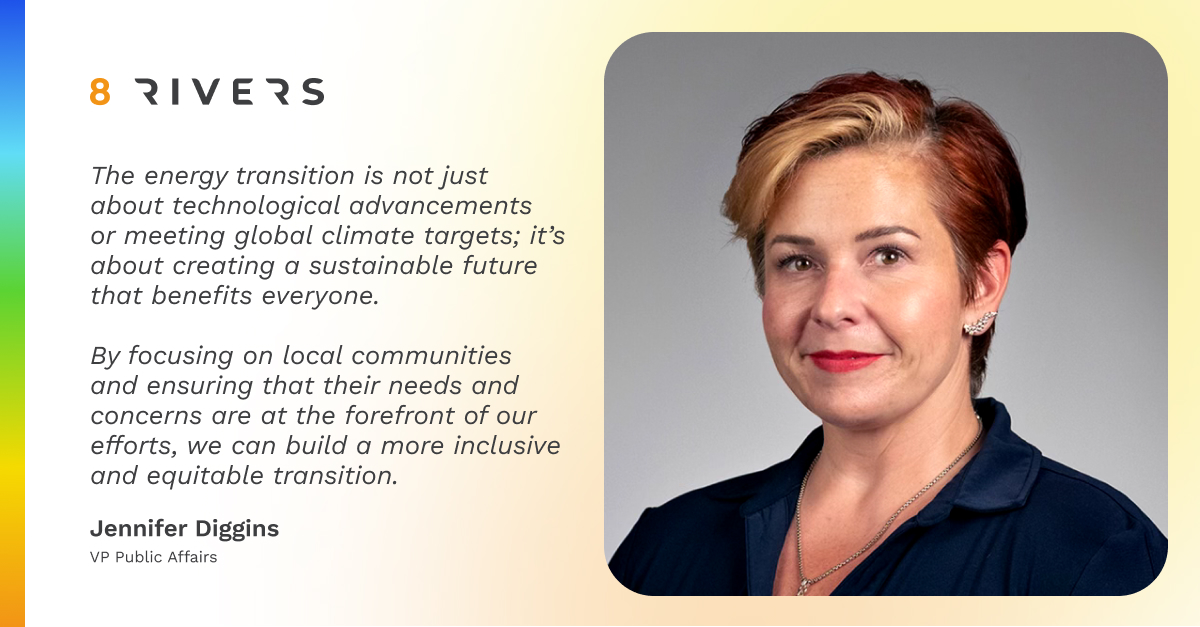By Jennifer Diggins, VP of Public Affairs at 8 Rivers

The energy transition is often discussed at a global level, highlighting its worldwide implications. However, the real work of this transition is happening in small, local neighborhoods and communities. Projects like ultra-low carbon hydrogen plants, direct air capture facilities, and carbon capture facilities represent the values of their host towns or cities. Ensuring that these projects reflect the needs and concerns of local residents is crucial for their success.
These local concerns vary widely. For example, a resident once expressed worry about how a carbon capture project might affect her rose bushes. While it might be tempting to dismiss such issues as minor, it’s essential to recognize their importance. After all, the success of these projects depends on community consensus and cooperation. For some, rose bushes might be as significant as broader environmental goals like achieving net-zero emissions or enhancing carbon storage. Sometimes, saving the rose bushes becomes the goal itself.
Focusing on such concerns highlights a critical principle of community engagement in the age of the energy transition: listening is paramount. At 8 Rivers, we strive to ensure that residents’ rose bushes are just as vibrant after a facility is operational as they were before. We also work to provide careers, educational training, and skill-building opportunities for local community members. Minimizing disruption to everyday life, whether it’s managing vehicle congestion, reducing noise, or preserving views, is a priority because these are the aspects of daily life that matter to people.
Our ability to address these issues effectively stems from our commitment to listening. Before even announcing a project, we invest time in understanding the community. We ask ourselves: What kind of people live here? What do they care about most?
 Our team at a Cormororant Clean Energy community event in Port Arthur, Texas
Our team at a Cormororant Clean Energy community event in Port Arthur, Texas
By holding regular meetings with key stakeholders and listening to their concerns, we can tailor our approach to best address these issues. For instance, we might hire a part-time police officer to manage increased traffic flow during project construction. These measures are a small price to pay to build a bridge towards community acceptance. Overcoming such obstacles early on can make the difference between a project’s feasibility and its failure. Investing upfront in community engagement leads to long-term cost savings.
As an industry, our focus should be on collective benefit. This means tackling air and water pollution, creating good jobs, and preserving or expanding green spaces. Making communities part of our journey and helping them see the collective benefit is essential. We have an opportunity, as a nascent industry, to set a positive precedent from the start.
Community engagement is not just about addressing concerns but also about integrating the community into the broader vision of the energy transition. This involves creating a sense of ownership and participation among residents. By involving them in decision-making processes and ensuring their voices are heard, we can foster a collaborative environment where everyone feels invested in the project’s success.
For instance, in addition to regular stakeholder meetings, we can organize community workshops and information sessions to educate residents about the benefits and potential impacts of the projects. By providing transparent and accessible information, we can build trust and understanding. Furthermore, by showcasing successful case studies from other communities, we can illustrate the tangible benefits that these projects can bring, from improved local air quality to job creation and economic growth.
Another critical aspect of community engagement is addressing the specific needs of vulnerable populations. This includes ensuring that low-income households, elderly residents, and other marginalized groups are not disproportionately affected by the projects. We must develop targeted initiatives to support these groups, such as offering job training programs tailored to their needs or implementing noise reduction measures in residential areas.
The energy transition is not just about technological advancements or meeting global climate targets; it’s about creating a sustainable future that benefits everyone. By focusing on local communities and ensuring that their needs and concerns are at the forefront of our efforts, we can build a more inclusive and equitable transition. This requires a commitment to ongoing dialogue, transparency, and a willingness to adapt our approaches based on community feedback.
In conclusion, the success of the energy transition relies on the active participation and support of local communities. By prioritizing listening and engagement, we can ensure that projects not only achieve their environmental goals but also enhance the quality of life for residents. As we move forward, let’s embrace a new playbook for what good looks like—one that values community input, fosters collaboration, and builds a sustainable future for all.
Follow us on LinkedIn to keep up with our event schedule and meet us on the road!